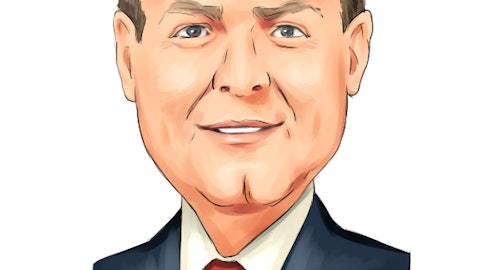Avery Dennison Corporation (NYSE:AVY) Q4 2022 Earnings Call Transcript February 2, 2023
Operator: Ladies and gentlemen, thank you for standing by. During the presentation, all participants will be in a listen-only mode. Afterwards, we’ll conduct a question-and-answer session. Welcome to Avery Dennison’s Earnings Conference Call for the Fourth Quarter and Full Year ended on December 31, 2022. This call is being recorded and will be available for replay from 4:00 PM Eastern Time today through midnight Eastern Time, February 05. To access the replay, please dial (800) 633-8284 or 1 (402) 977-9140 for international callers. The conference ID number is 2202-0690. I would now like to turn the conference over to John Eble, Avery Dennison’s Head of Investor Relations. Please go ahead.
John Eble: Thank you, Frank. Please note that throughout today’s discussion, we’ll be making references to non-GAAP financial measures. The non-GAAP measures that we use are defined, qualified and reconciled from GAAP on schedules A4 to A10 of the financial statements accompanying today’s earnings release. We remind you that we’ll make certain predictive statements that reflect our current views and estimates about our future performance and financial results. These forward-looking statements are made subject to the safe harbor statement included in today’s earnings release. On the call today are Mitch Butier, Chairman and Chief Executive Officer; Deon Stander, President, and Chief Operating Officer; and Greg Lovins, Senior Vice President and Chief Financial Officer. I’ll now turn the call over to Mitch.
Mitch Butier: Thanks, John, and good day, everyone. We posted impressive results in 2022 in the face of an extremely challenging environment. We delivered another year of double-digit EPS growth on a constant currency basis. EPS is up 40% from 2019 levels, reflecting our consistent ability to deliver year-over-year earnings growth, despite concurrent and compounding challenges. Both our Materials Group and Solutions Group delivered solid top and bottom line results last year, while driving further acceleration in the pace of Intelligent Labels adoption. As you can see, we have changed our operating segments. We combined LGM and IHM to create the Materials group. Over the past few years, we’ve been leveraging more and more of the operational capabilities and technologies across LGM and IHM to enhance our ability to win in each business’s respective marketplace.
The combination of these two businesses is the next evolutionary step of this strategy. As for RBIS, we renamed the segment the Solutions Group to better reflect the increasingly broader reach and ambitions of our solutions beyond Retail. Deon will provide color on segment performance in a moment. Both businesses delivered impressive results in 2022, especially considering the significant macro headwinds we faced, including sizable currency movements, pandemic-driven demand challenges in China, the Russian war in Ukraine and, of course, significant inflation and supply chain disruptions. In addition to the unique challenges that the inflation and supply chain disruptions presented, this also caused an increase in demand volatility throughout the year.
The high inventory levels downstream from us, which we called out at the start of the year, were built further midyear. Then as supply chain constraints began to ease and raw material inflation showed signs of moderating, inventories were reduced swiftly beginning in November. This trend continued into December and January. Now while we anticipated the inventory buildup downstream from us to unwind at some point, the pace and magnitude of reductions was faster and greater than we expected and then we have seen in past corrections. Overall, while this put significant pressure on our financial results in Q4 and now in Q1 of this year, we see the reduction of excess inventory is a good thing as it positions our industries and business to return to a more normalized growth trajectory beginning in Q2.
That said, such a sudden decline in volume is indicative of patterns of previous macro slowdowns. We have been activating countermeasures accordingly. We have initiated temporary cost reduction actions, ramping up restructuring initiatives and paring back capital investments in our base business — base businesses while protecting investments in our high-growth initiatives, particularly Intelligent Labels, both organically and through M&A. Despite a challenging macro environment, we are targeting mid- to single-digit EPS growth in 2023, reflecting a soft Q1 driven by inventory corrections, followed by a second half run rate for EPS of more than $10. Our strong track record over the long term reflects the strength of our markets, our industry-leading positions, the strategic foundations we’ve laid and our agile and talented team.
Our playbook is working extremely well as we continue to focus on five overarching strategic pillars: to drive outsized growth in high-value categories; grow profitably in our base businesses; focused relentlessly on productivity; effectively allocate capital; and lead in an environmentally and socially responsible manner. As you know, a key element of our strategy to drive outsized growth in high-value categories has been our focus on Intelligent Labels, which we expect to be a $1 billion platform this year. We continue to invest in this platform as we expect it to grow more than 20% annually in the coming years. This is a tremendous example of our strategy at work. We’ve refined our strategies over time, raising the bar for ourselves in the process to ensure we continue to deliver superior value creation for all of our stakeholders.
We have a clear set of objectives and strategies focused on their mutual success. We’re making great progress towards our 2030 sustainability goals and are on track to deliver our 2025 financial objectives, which Greg will walk through momentarily. The ability of our teams to drive these strategies forward over the long haul and deliver these impressive results, including once again achieving double-digit EPS growth last year, is remarkable. So I once again thank our entire team for their tireless efforts to keep one and other safe while delivering for all of our stakeholders. Over to you, Deon.
Deon Stander: Thanks, Mitch, and hello, everyone. As Mitch said, we delivered impressive results in 2022 in the face of an extremely challenging environment. I’ll now provide more color on our segment performance. Materials Group delivered 11% organic growth for the year, driven by higher pricing and a low single-digit volume decline, excluding the impact of exiting Russia. Operating profit for the segment was strong, up mid-single digits ex currency as unprecedented levels of inflation were met with significant pricing actions to continue delivering strong returns in this already high EVA business. Over the long term, Label materials volumes continue to grow at GDP plus, up 3% annually in 2022 compared to 2019. In the fourth quarter, Materials Group sales were up 2% ex currency and on an organic basis, driven by a mid-teens impact from higher prices, largely offset by a low double-digit volume decline.
Following a period of material constraints earlier in the year, downstream inventories that began the year elevated were built up even further midyear. And the supply chain disruption eased and inflation abated, customers rapidly destocked as they began to optimize inventory levels in the fourth quarter. On an organic basis for the quarter, Label materials were up low single digits, graphics and Reflective sales were up low single digits and Performance Tapes and Medical sales were up low double digits. Looking at Label materials organic volume growth in the quarter by region, combined North America and Western Europe were down mid-teens. Overall emerging markets were down mid-single digits, with China volumes down low single digits, and the exit of Russia lowered total Label materials growth by roughly three points.
Given the soft environment over the past few months and the expectation for moderating economic growth, we have been activating our cost-saving initiatives, both temporary and structural. We are focused on optimizing our cost structure and protecting the bottom line in this lower volume period while continuing to manage strong pricing discipline. Given all these factors, we expect Q1 to look similar to Q4, anticipating roughly one to two weeks of inventory to be further reduced across the industry with destocking concluding in the earlier part of the year. Following the inventory correction, given the durability of our diverse and growing end markets, along with our market-leading position, we expect to rebound to GDP plus growth from Q2 onwards.
Stepping back, the combination of LGM and IHM not only enables us to fully leverage the capabilities of the whole business but strengthens our ability to win in the broader functional materials market, while also continuing to deliver EVA growth. Turning to the Solutions Group. Organic growth sales were up 5% for the year, driven by strong growth in high-value solutions and posted record margins, despite the impact of retailer destocking. In the fourth quarter, Solutions Group sales were down 7% ex currency and 8% on an organic basis. The base business was down high teens organically, partially offset by mid-single-digit organic growth in the high-value categories. Apparel inventory reductions were broad-based across all channels in the fourth quarter, and destocking continued in January.

Photo by Marcell Viragh on Unsplash
In this segment, we expect destocking to continue through Q1 and into Q2 as retailers factor high inventories, muted holiday performance and lower sentiment into their near-term sourcing plans. Similar to the Materials segment, we are activating cost-saving initiatives, both temporary and structural. We expect our apparel business to return to historic GDP growth in the second half of the year and for the Solutions segment to additionally benefit from the significant growth increasing through the year in our Intelligent Labels platform. Turning to Intelligent Labels; enterprise-wide sales were up mid-teens on an organic basis in 2022. Momentum in this roughly $800 million platform continues to accelerate. This business has more than tripled in size over the last five years, averaging 20% annual growth on an organic basis.
The strong growth over this time horizon has primarily been driven by apparel as we continue to drive further adoption of the technology, extend use cases and expand programs with major customers in this key end market. And while we continue to expect apparel to be the largest volume in the coming years, we see even greater opportunity over the long run in other key untapped markets. In logistics, which is expanding from targeted applications such as special package handling, to broad-based use cases such as improving miss loads and routing accuracy. In food, where we are seeing promising pilots in QSR and grocery, in use cases covering freshness and labor efficiency and in general retail, where the technology is being expanded beyond apparel.
The benefits of our Intelligent Label technology and Solutions are clear. The increased supply chain and inventory visibility, lower cost and improved speed of operations, reduce waste and ultimately enhance the experience of end consumers. As a leader in ultrahigh frequency RFID, we are extremely well positioned to not only capture these new opportunities but lead at the intersection of the physical and digital. To that end, we are continuing to invest in developing new applications and markets; adding new technologies, both physical and digital; increasing our manufacturing capacity, including investing more than $100 million in a new facility in Mexico for growth in the back half of 2024 and beyond; and expanding our team, the best, most experienced in the space.
Our strategies here continue to pay off. We remain confident this will be a $1 billion platform in 2023 and are targeting more than 20% growth in the coming years. Lastly, we continue to deploy capital in other high-value solutions. Signing an agreement in January to acquire Thermopatch, a business specializing in external embellishments with roughly $40 million in annual revenue. In summary, we delivered impressive results in 2022 in the face of an extremely challenging environment. Inventory destocking is impacting our results near term, and we are making adjustments accordingly. I remain extremely confident in the underlying fundamentals and prospects of our business over the long run. And with that, I’ll hand the call over to Greg.
Greg Lovins: Thanks, Deon. Hello, everybody. I’ll first provide some additional color on our results and our performance against our long-term targets and then walk you through our 2023 outlook. In the fourth quarter, we delivered adjusted earnings per share of $1.65, down 14% ex currency compared to prior year, driven by a low double-digit volume decline due primarily to inventory destocking. For the full year, we delivered adjusted earnings per share of $9.15, up 11% ex currency, with organic sales growth of 10% as pricing offset a low single-digit volume decline. Our full year adjusted earnings per share was in line with the midpoint of our original guidance from the beginning of the year, adjusted for currency translation.
For the year, we generated $667 million of free cash flow, and we invested $300 million on fixed capital and IT projects as we continue to accelerate investments in Intelligent Labels. Free cash flow conversion in 2022 was lower than we targeted, including higher-than-anticipated working capital driven largely by inventory. The high inventory levels include some strategic inventory builds in areas such as RFID chips. In addition, we still have some inventory we are working to optimize given all the supply chain disruptions throughout the year. We’re clearly focused on this and expect to make strong progress as the year progresses. Despite this challenge, our average free cash flow conversion over the past three years has been roughly 100% of GAAP net income, and we expect this to continue in 2023.
Our balance sheet remains strong with a net debt to adjusted EBITDA ratio at year-end of 2.2x. Our current leverage position gives us ample capacity to continue investing organically as well as through strategic acquisitions while continuing to return cash to shareholders in a disciplined way. During the year, we returned $618 million to shareholders through the combination of share repurchases and a growing dividend as well as deployed $40 million for M&A. Turning to our long-term targets. Slide 9 of our supplemental presentation materials provides an update on our progress against the long-term financial targets that we communicated in 2021. Recall, this represents our fourth set of long-term goals after meeting or beating our previous three sets.
The consistent execution of our key strategies enables us to continue delivering against our targets with an overriding focus on delivering GDP-plus growth and top quartile return on capital over the long term. Through the first two years of the cycle, sales growth on a constant currency basis was 16% annually, well above our target and GDP, driven by strong volume growth, higher pricing and M&A. Adjusted EBITDA dollars have grown 28% compared to 2020, with adjusted EBITDA margin of 15.1% in 2022. As always, our focus will continue to be the optimal balance of growth, margins and capital efficiency to drive incremental EVA over the long term. We remain confident in achieving our 2025 margin target of 16% plus as part of that EVA equation. Adjusted earnings per share grew 13.5% annually over the past two years, surpassing our target of 10%.
And our return on capital was 17.4% in 2022 and in the top quartile relative to our capital market peers. Given the diversity of our end markets, our strong competitive advantages and resilience as an organization to adjust course when needed, we’re confident in our ability to continue delivering against these targets through a wide range of business cycles. Now shifting to our outlook for 2023; as Mitch and Deon commented on, we are starting out the year in a challenging volume environment as we continue to see destocking in the first quarter in both the Label materials and Apparel businesses. We have been activating countermeasures and are confident in our ability to grow earnings for the year through a variety of environments. As we look at how we expect that to play out across the year, given the continued destocking, we expect the first quarter to be comparable to Q4 of 2022, which was $1.65 in adjusted earnings per share.
Following Q1, we expect to see a strong rebound beginning in Q2 and moving through the back half of the year, with a second half earnings run rate of more than $10 annualized. In the second half, we expect downstream inventories will normalized, China to be rebounding and our growth in Intelligent Labels will build as we move through the year as the new programs roll out in areas such as logistics. For these reasons, we expect significant earnings growth in the back half and also see a very strong trajectory as we exit 2023. For 2023 overall, we anticipate adjusted earnings per share to be in the range of $9.15 to $9.55. To highlight the key drivers of the high end of our 2023 EPS guidance compared to prior year, we anticipate roughly 5% organic sales growth, with the majority from higher prices.
We estimate restructuring savings net of transition costs of roughly $0.40 and another roughly $0.30 from temporary cost reduction actions. And we expect strategic growth investments of roughly $0.25, and we estimate net nonoperational items, headwinds from interest, currency and tax and a benefit from share count to be roughly $0.25 net headwind. In summary, through this dynamic environment, we’re pleased with the strategic and financial progress we made against our long-term goals in 2022. Despite the near-term challenges, we remain confident in our ability to continue to deliver exceptional value through our strategies for long-term profitable growth and disciplined capital allocation. Now we’ll open up the call for your questions.
See also 10 Most Undervalued Tech Stocks To Buy and 12 Most Undervalued Travel Stocks To Buy.
Q&A Session
Follow Avery Dennison Corp (NYSE:AVY)
Follow Avery Dennison Corp (NYSE:AVY)
Operator: Our first question comes from Ghansham Panjabi with Robert W. Baird & Co.
Ghansham Panjabi: Can you just give us yes — can you just sort of elaborate on your view that the near term is largely inventory destocking versus something more broader in terms of recession? I mean you yourself are enacting a recession scenario plan. How do you — what gives you confidence that this is purely more or less inventory destocking versus something more broader than that?
Deon Stander: Ghansham, this is Deon. When you look at the volume that we saw come out in Q4, largely because the inventory destocking, we see that trend also continue in January that we saw in both November and December. And we expect in our Materials business for that destocking to be completed largely by the first quarter. On the Apparel business, as I called out, we both see inventory destocking happening as we ran through the back half of last year and will continue in Q1 and into Q2 as well. While we don’t have as much forward visibility and also because of the Lunar Year, it’s clear that retailers are also factoring in sentiment into their forward volume ordering plans as well. But we anticipate that by the second half of the year that Apparel business will return to its historic GDP growth rates.
And then when you factor in our additional growth that we’re going to get from our IO platform, the rebounding of China, we expect to be able to deliver above GDP growth rates in the second half of the year.
Mitch Butier: And Ghansham, just to build on that. It’s also what we’re hearing from the marketplace, our customers are talking about the fact that they had built inventory throughout the year leading up to Q4 as well as the end customers, CPG firms and so forth and the same thing on the Apparel side. So it’s market Intel. It’s comparing — we have pretty clear links between our product consumption and demand relative to consumption of nondurable consumer goods, for example, and they definitely have disconnected to the negative. They were a bit positive early in 2022, even the end of ’21, which is why we called out that we thought there was some excess inventory in the system at the time, and that continued throughout the year.
And then it’s unwinding just at a much quicker pace than we traditionally see. So there’s a number of vectors we’re looking at triangulate it gives us a lot of confidence. This is a majority of inventory correction. That said, we do expect and consumption to moderate a bit. You’re already seeing it in Apparel with a weak holiday season. And as far as you’re looking at the GDP outlooks for at least Europe and North America, they’re modest to a slight recession.
Operator: Our next question comes from Adam Josephson with KeyBanc Capital Markets.
Adam Josephson: Mitch, just one last one along similar lines to Ghansham’s question, which is, if you’re anticipating conditions to get more or less back to normal in the second half, why they need to activate this recession scenario, if it’s just a 2-quarter blip? And what exactly does that entail for you because if the economy gets back to normal in second half, will you still need to do that recession activation, if you will?




